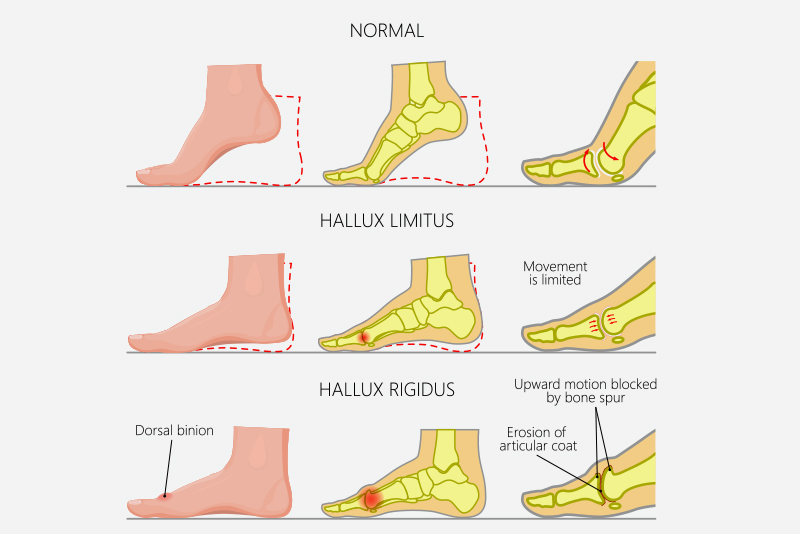If your big toe is stiff and sore, and you have trouble bending it, you may have Hallux Limitus. The hallux is the big toe joint, where the toe connects to the foot. This condition can lead to an increasingly painful big toe, especially when squatting, running and walking.
What causes Hallux Limitus?
Hallux Limitus usually starts off with a slight ache and can get worse with time which is why it’s important to seek treatment sooner than later. There are preventive measures you can take to stop it from progressing to the next stage, which is Hallux Rigidus, or arthritis of the big toe.
Some common causes:
- Injury – if have stubbed or broken your big toe and this has created trauma to the joint, it can cause stiffening of the joint over time.
- Ill-fitting shoes – wearing shoes that are too small or too high can put too much pressure on the toes, squashing them and causing trauma to the joint.
- Overuse – repetitive movement through an activity or sports can place too much pressure on the big toe joint, causing strain the joint.
- Arthritis – gout, osteoarthritis and rheumatoid arthritis all cause inflammation and may contribute to stiffening of the big toe.
- Foot alignment – you may have a problem with your foot position and alignment when walking or standing, which can interfere and cause a reduced range of movement in the joint.
Hallux Limitus can also cause general forefoot pain and a number of other issues within the feet and legs as people change their gait to allow more movement where the joint is limited. This can transfer to the small foot bones and joints, up the leg to the knees, hips and lower back creating other problems areas.
What are the symptoms of Hallux Limitus?
- The big toe won’t bend backward and forward – the range of motion is limited
- When the toe does bend, it’s quite sore
- Swelling and redness around the big toe joint
- It feels painful to walk, run and stand from a squatting position and run
- Your gait or walking pattern changes
Hallux Limitus is a condition that progresses if it is not diagnosed and treated. Eventually the big toe joint becomes more inflamed and can deteriorate, causing arthritis of the big toe or Hallux Rigidus.
Treatment of Hallux Limitus
At Sanders Podiatry, we’ll assess the condition of your feet and understand the reasons for the stiffness in the big toe. We’ll asses your gait and posture and then decide on a treatment plan for your specific needs. Treatment options include:
- Manual techniques to improve the range of movement.
- Insoles and orthoses to offload pressure and improve the alignment and function of the foot.
- Footwear that provides space for the toes to move.
- Strapping or taping for short term relief.
Self-help tips at home
- Stretching – gentle stretching of the big toe up, down and to each side while holding the ball of your foot with your other hand to support it.
- Hold the ball of the foot with one hand and very gently pull the big toe forward which will help to release some tension in the joint.
- Place a ball under your foot and step on it gently, keep this pressure on for 30 seconds, this will help to release tension in the foot in general.
Make an appointment with our family-friendly podiatry team
Call us and make an appointment to have your big toe looked at. You don’t want this stiffness to increase as you get older because it may stop you from doing activities you enjoy. With some gentle stretching, therapy and other measures, we’ll help you to gain the range of motion in your big toe and prevent any further damage.
Our podiatry clinics are in three locations around Adelaide.
Sander Podiatry Adelaide – 08 8379 1456 (Greenhill Podiatry)
